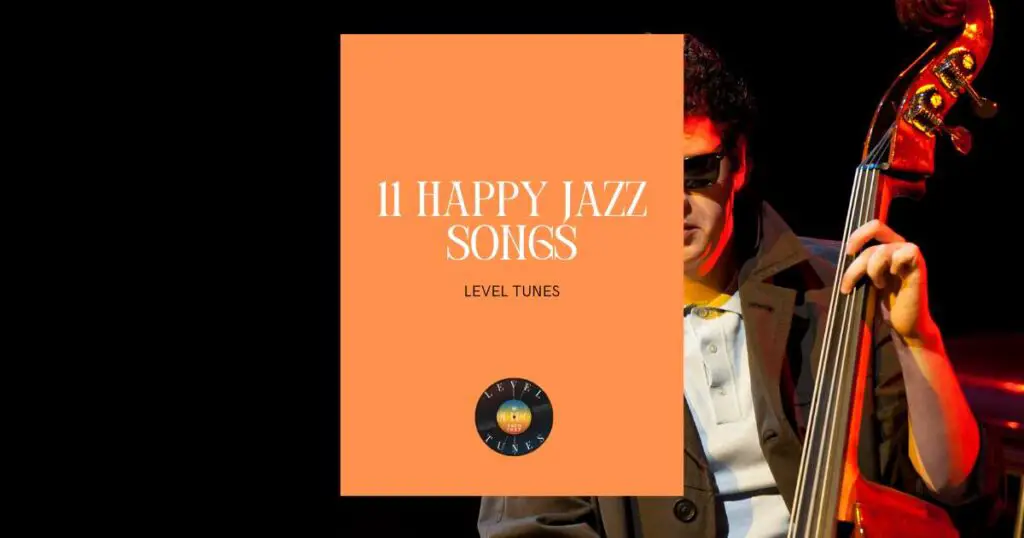11 Happy Jazz Songs: Swing, Groove, and Smile
Hey there, fellow music enthusiasts! TBone here, the proud owner of Level Tunes and a lifelong devotee to the magic of melodies.
With over 20 years spinning decks and diving deep into the music industry’s treasures, I’ve developed a keen ear for tunes that lift the spirit. Today, I’m thrilled to share with you a special collection close to my heart: 11 happy jazz songs that sparkle with joy and sophistication.
Jazz has always been a genre that resonates with me deeply, blending skill, soul, and a splash of spontaneity.
These tracks are my go-to when I need a boost, embodying the vibrant energy and innovation that jazz is all about.
Join me as we explore these auditory delights, each one a testament to the genre’s enduring appeal and its power to bring a smile to our faces. Let’s dive into the world of jazz, where every note promises a journey into happiness.
Here are the happy jazz songs that you can check out:
List Of Happy Jazz Songs
Happy jazz songs in a list format:
“Take Five” by Dave Brubeck
From the album Time Out released in 1959 under Columbia Records, “Take Five” is arguably one of the most iconic jazz pieces out there. Written by Paul Desmond and performed by The Dave Brubeck Quartet, this song is a quintessential example of cool jazz that transcends time. Its unconventional 5/4 time signature and catchy saxophone melody by Paul Desmond, coupled with Brubeck’s soothing piano lines, make it irresistibly engaging. I chose this song for its groundbreaking approach to rhythm and melody, which still feels fresh and innovative. It’s a piece that encapsulates the joy and experimentation of jazz, making it impossible not to nod along with.
“Watermelon Man” by Herbie Hancock
Herbie Hancock’s “Watermelon Man” from the album Takin’ Off, released in 1962 under Blue Note Records, is a funky, soulful track that captures the essence of jazz’s playful side. This song, featuring Hancock’s inventive piano and Dexter Gordon’s tenacious saxophone work, is a testament to Hancock’s genius in blending different elements of jazz into a cohesive, joyful sound. The song’s infectious groove and memorable melody are why it’s on this list. It embodies the spirit of jazz’s ability to innovate while keeping listeners engaged and entertained.
“Cantaloupe Island” by Herbie Hancock
Another Herbie Hancock classic, “Cantaloupe Island,” from the 1964 album Empyrean Isles under Blue Note Records, stands out for its distinctive blend of jazz, funk, and blues. The song’s laid-back groove, combined with Hancock’s minimalist piano riff, Freddie Hubbard’s crisp trumpet lines, and Ron Carter’s steady bass, creates a mood that’s both cool and inviting. I chose this track for its seamless fusion of styles and its ability to create a relaxed, yet upbeat atmosphere. It’s a perfect example of Hancock’s innovative spirit and his ability to make jazz accessible to a broader audience.
“Birdland” by Weather Report
From the album Heavy Weather released in 1977 under Columbia Records, “Birdland” is a lively piece that showcases Weather Report’s fusion of jazz, rock, and world music. Named after the famous New York jazz club, this song features Joe Zawinul’s energetic synthesizer work and Wayne Shorter’s expressive saxophone. “Birdland” is celebrated for its vibrant rhythm and melody, making it a staple in the jazz fusion genre. I love this song for its dynamic energy and the way it captures the spirit of an era where jazz was exploring new territories.
“Feeling Good” by Nina Simone
Nina Simone’s rendition of “Feeling Good,” from her 1965 album I Put a Spell on You under Philips Records, is a powerful expression of joy and liberation. Simone’s deep, emotive voice, paired with the dramatic arrangement, transforms the song into an anthem of resilience and hope. Although not written by Simone herself, her interpretation is the most iconic, embodying the transformative power of jazz to convey deep emotions. This song is on the list for its soul-stirring performance and its ability to uplift and inspire.
“Moanin'” by Art Blakey and The Jazz Messengers
“Moanin'” is a hard bop classic from the album of the same name, released in 1958 under Blue Note Records. Written by pianist Bobby Timmons and performed by Art Blakey’s Jazz Messengers, this song is a masterclass in groove, blues elements, and the call-and-response tradition. The powerful opening by Timmons, followed by Blakey’s explosive drumming and Lee Morgan’s fiery trumpet solo, makes “Moanin'” irresistible. I chose it for its raw energy and the way it captures the essence of the hard bop movement, emphasizing emotion and rhythm.
“In the Mood” by Glenn Miller
Glenn Miller’s “In the Mood” from the 1939 album Glenn Miller is a swing era hallmark that has become one of the most recognizable tunes in jazz history. This song, with its catchy saxophone riff and swinging rhythm, captures the optimistic spirit of the pre-war years. It’s a track that gets people on their feet, thanks to its energetic brass sections and relentless drive. “In the Mood” is included for its timeless appeal and its role in making jazz a central part of American culture.
“Sing, Sing, Sing” by Benny Goodman
From the 1938 live recording at Carnegie Hall, “Sing, Sing, Sing” by Benny Goodman and his orchestra is a quintessential swing track known for its driving rhythm and memorable clarinet solos by
Goodman himself. This song, often associated with the height of the Swing Era, is an exhilarating piece that features the legendary Gene Krupa on drums, whose performance adds a dynamic energy that’s hard to match. The extended solos and the call-and-response between the brass and reeds showcase the tight ensemble work and improvisational skills that are hallmarks of Goodman’s band. “Sing, Sing, Sing” is a celebration of the joy and communal spirit of jazz, making it a must-have on any list of happy jazz songs. I love it for its infectious rhythm and the way it brings together some of the best elements of big band music—impressive solos, tight ensemble sections, and an irresistible beat that makes you want to dance.
“A Night in Tunisia” by Dizzy Gillespie
Dizzy Gillespie’s “A Night in Tunisia,” from the 1942 album Groovin’ High, is a pioneering work that introduced Afro-Cuban rhythms to the jazz world. This song, with its complex rhythms and innovative harmonies, showcases Gillespie’s virtuoso trumpet playing and his ability to blend different musical traditions into a cohesive and exciting new style. The song’s signature motif and its adventurous solos by Gillespie and other musicians who have covered this classic over the years, like Charlie Parker, make it a standout track. I chose “A Night in Tunisia” for its historical significance and its exhilarating blend of jazz improvisation and Afro-Cuban rhythm, offering a joyful and thought-provoking listening experience.
“Spain” by Chick Corea
From the 1972 album Light as a Feather by Chick Corea and Return to Forever, “Spain” is an exhilarating fusion of jazz, flamenco, and classical music. Inspired by Joaquín Rodrigo’s Concierto de Aranjuez, this piece features Corea’s mesmerizing keyboard work, Stanley Clarke’s virtuosic bass, and Airto Moreira’s subtle yet effective percussion. “Spain” is celebrated for its complex arrangements and emotive melody, embodying the spirit of exploration and innovation in jazz. I love this song for its ability to transport listeners to another place and time through its intricate harmonies and rhythms, showcasing the depth and diversity of jazz music.
“It Don’t Mean a Thing (If It Ain’t Got That Swing)” by Duke Ellington
This classic by Duke Ellington, from the 1932 album It Don’t Mean a Thing, is one of the most enduring anthems of the swing era. Featuring the unforgettable vocals of Ivie Anderson and a band that included jazz legends like Johnny Hodges and Cootie Williams, this song captures the essence of swing with its lively rhythm, catchy melody, and the famous refrain that has become a motto for jazz musicians everywhere. I selected this song for its historical importance and its timeless message that music needs to swing to truly resonate. Ellington’s genius in composition and arrangement shines through, making it a joyful and essential piece of jazz history.
“Chega De Saudade” by João Gilberto
Often credited with launching the bossa nova movement, João Gilberto’s “Chega De Saudade” from the 1959 album of the same name is a masterpiece of subtlety and emotion. This song, with Gilberto’s soft vocals and innovative guitar style, alongside Antonio Carlos Jobim’s lush harmonies, encapsulates the melancholic yet hopeful spirit of bossa nova. The gentle rhythms and intimate delivery make “Chega De Saudade” a joyful yet reflective piece, showcasing the power of simplicity in music. I included it for its groundbreaking approach to rhythm and melody, and its influence on the global jazz scene, making it a song that brings happiness through its serene and beautiful composition.
Fun Facts: Happy Jazz Songs
“Take Five” by Dave Brubeck
- Fact: “Take Five” is the best-selling jazz single of all time. Despite its unusual 5/4 time signature, which was rare in jazz music at the time, it gained widespread popularity and has remained a beloved classic.
“Watermelon Man” by Herbie Hancock
- Fact: Hancock was inspired to write “Watermelon Man” by his childhood memories of a watermelon vendor in his neighborhood. The song’s intro mimics the sound of a vendor calling out, creating a direct link to Hancock’s personal history and the song’s playful groove.
“Cantaloupe Island” by Herbie Hancock
- Fact: “Cantaloupe Island” has been extensively covered and sampled by various artists across different genres, demonstrating its wide-reaching influence. Notably, it was famously sampled by Us3 for their 1993 hit “Cantaloop (Flip Fantasia),” bringing the song’s catchy riff to a new generation of listeners.
“Birdland” by Weather Report
- Fact: “Birdland” is named after the famous New York jazz club Birdland, which was itself named in honor of Charlie Parker, whose nickname was “Bird.” The song became one of Weather Report’s most recognizable tunes and a jazz fusion classic.
“Feeling Good” by Nina Simone
- Fact: While “Feeling Good” has been covered by many artists, Nina Simone’s version stands out for its emotional depth and has been used in numerous movies, television shows, and commercials, showcasing its enduring appeal and versatility.
“Moanin'” by Art Blakey and The Jazz Messengers
- Fact: “Moanin'” not only showcases the hard bop style but also became an anthem of sorts for the genre. Its call-and-response pattern is a nod to gospel and blues roots, creating a deep connection with African American musical traditions.
“In the Mood” by Glenn Miller
- Fact: “In the Mood” was inducted into the Grammy Hall of Fame in 1983, an honor bestowed on recordings of lasting qualitative or historical significance. This underscores the song’s pivotal role in the development of swing music and its impact on American culture.
“Sing, Sing, Sing” by Benny Goodman
- Fact: The version of “Sing, Sing, Sing” recorded at Carnegie Hall in 1938 is renowned for its length (over 12 minutes) and energy. It’s one of the most famous live recordings in jazz history, showcasing the electrifying atmosphere of a Goodman concert.
“A Night in Tunisia” by Dizzy Gillespie
- Fact: Gillespie’s “A Night in Tunisia” is considered a pioneering piece in the development of bebop and Afro-Cuban jazz. Its complex rhythms and innovative chord progressions marked a significant departure from the swing style and influenced generations of jazz musicians.
“Spain” by Chick Corea
- Fact: Corea’s “Spain” incorporates elements of classical music, specifically Rodrigo’s “Concierto de Aranjuez,” showcasing jazz’s ability to merge with other genres. The song’s intricate arrangement and fusion of styles make it a standout piece in Corea’s repertoire and a favorite among jazz fusion aficionados.
“It Don’t Mean a Thing (If It Ain’t Got That Swing)” by Duke Ellington
- Fact: This song coined the phrase that would come to define the swing era, emphasizing the importance of the swing feel in jazz. Its catchy refrain has become a jazz mantra, highlighting the genre’s emphasis on rhythm and groove.
“Chega De Saudade” by João Gilberto
- Fact: “Chega De Saudade” is often cited as the first recorded bossa nova song, marking the beginning of the genre that would take the world by storm. Gilberto’s innovative guitar technique and vocal style set the standard for bossa nova and influenced countless musicians worldwide.
Exploring these jazz classics unveils the soul of a genre that continues to inspire and uplift audiences worldwide. From Brubeck’s rhythmic innovations to Gilberto’s serene bossa nova, each song carries a story that resonates through the ages, inviting us to feel the joy and depth of jazz.
Thanks for reading.
TBone




